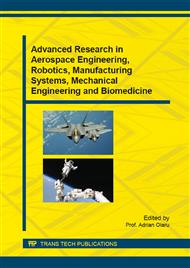p.75
p.80
p.85
p.92
p.99
p.104
p.110
p.117
p.122
The Reduction of Errors of Bridge Crane Loads Movments by Means of Optimization of the Spatial Trajectory Size
Abstract:
The article dwells upon the results of study of theshape influence of size of load’s motion using the sigmoidal functions of traversingsingle obstacle on the arc with suppression of load’s oscillations to theaccuracy figure of the trajectory’s realization. The possibility of thereduction of the maximum and average error by means of the little changing of the value ofthe arc’s lateral deformation for a fixed traveling time is shown in thisarticle. The functional dependencies of the maximum and average errors oftrajectory implementation from corrected value of the maximum arc’sdisplacement of required load's trajectory in lateral side to bypass obstaclesand from increasing of corrected value of the maximum displacement of the arcare given too.
Info:
Periodical:
Pages:
99-103
Citation:
Online since:
November 2015
Authors:
Keywords:
Price:
Сopyright:
© 2015 Trans Tech Publications Ltd. All Rights Reserved
Share:
Citation:


